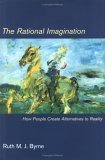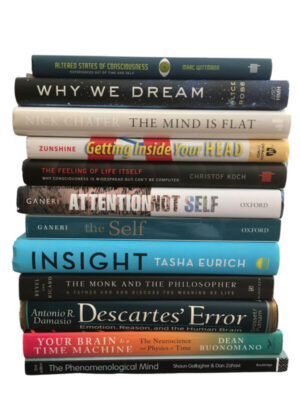August 23, 2007

The Rational Imagination: How People Create Alternatives to Reality by Ruth M.J. Byrne – discusses research on cognitive processes involved in counterfactual (“if only…”) and semifactual (“even if…”) thinking.
excerpt from the summary, p. 214:
This book has sketched seven principles derived from the study of reasoning that explain imaginative thoughts. People think about possibilities, … true possibilities. They do not tend to think about false possibilities. They also tend to think about just a few of the true possibilities. People can think about dual possibilities… When they think about counterfactual possibilities, they can think about a possibility that is false, and they may even suppose it to be true. They keep track of whether the possibilities they think about are real or imagined. Dual possibilities are more mutable than single possibilities; people can more readily create a counterfactual alternative to a possibility when they have mentally represented it from the outset with a second possibility. People understand obligations by thinking about the forbidden possibility as well as the permitted possibility. They can imagine how a situation should have been different by mentally changing a forbidden possibility to be more like the permitted possibility. The possibilities people envisage encode temporal information about the order of events in the world. The seven principles are not intended as an exhaustive set; nonetheless this fragment provides the beginnings of an explanation of the counterfactual imagination, The principles help to explain some of the remarkable regularities in the counterfactual alternatives that people create. For example, they explain why people create counterfactual alternatives to actions, to controllable events, to forbidden events, and to recent events. They explain why counterfactual thoughts focus on enabling causal relations and semifactual thoughts focus on weak causal relations.
My claim is that the counterfactual imagination is rational. … the set of principles that guide the possibilities people think about when they reason also guide their imaginative thoughts.
more information at Google Book Search
Comments (0)
- mind
 “The Objects of Our Desire”, an article in today’s Washington Post discusses the new book
“The Objects of Our Desire”, an article in today’s Washington Post discusses the new book
Evocative Objects: Things We Think With , edited by Sherry Turkle, director of the MIT Initiative on Technology and Self. Evocative Objects is the first of a planned three-book series on technology and self.
, edited by Sherry Turkle, director of the MIT Initiative on Technology and Self. Evocative Objects is the first of a planned three-book series on technology and self.
See also Andy Clark, Natural-Born Cyborgs: Minds, Technologies, and the Future of Human Intelligence , suggesting humans are “beings primed by Mother Nature to annex wave upon wave of external elements and structures as part and parcel of their own extended minds.” (p. 31)
, suggesting humans are “beings primed by Mother Nature to annex wave upon wave of external elements and structures as part and parcel of their own extended minds.” (p. 31)
Comments (0)
- culture,mind,self
August 12, 2007
This is the concluding part of a list I started a few days ago, of new & forthcoming books in the neurosciences, including neuroscience applied to fields such as religion, ethics or psychotherapy. A cumulative list will be placed in the sidebar.
Neuropsychotherapy: How the Neurosciences Inform Effective Psychotherapy by Klaus Grawe (Mahwah, N.J.: Lawrence Erlbaum, 2007).
Neuroscience, Fourth Edition by Dale Purves (Sunderland, Mass.: Sinauer Associates, 2007). textbook
by Dale Purves (Sunderland, Mass.: Sinauer Associates, 2007). textbook
The Neuroscience of Psychological Therapies by Rowland W Folensbee (Cambridge [England] ; New York: Cambridge University Press, 2007).
by Rowland W Folensbee (Cambridge [England] ; New York: Cambridge University Press, 2007).
Neuroscience of Rule-Guided Behavior ed. by Silvia A Bunge; Jonathan D Wallis (New York : Oxford University Press, 2007) forthcoming Aug 29
ed. by Silvia A Bunge; Jonathan D Wallis (New York : Oxford University Press, 2007) forthcoming Aug 29
New Frontier of Religion and Science: Religious Experience, Neuroscience, and the Transcendent by John Hick (New York : Palgrave Macmillan, 2007).
by John Hick (New York : Palgrave Macmillan, 2007).
On Willing Selves: Neoliberal Politics and the Challenge of Neuroscience ed. by Sabine Maasen; Barbara Sutter (Basingstoke: Palgrave Macmillan, 2007) forthcoming Oct 2
ed. by Sabine Maasen; Barbara Sutter (Basingstoke: Palgrave Macmillan, 2007) forthcoming Oct 2
Proust Was a Neuroscientist by Jonah Lehrer (Boston : Houghton Mifflin Co., 2007) forthcoming Nov 1 (author’s blog, “The Frontal Cortex”)
by Jonah Lehrer (Boston : Houghton Mifflin Co., 2007) forthcoming Nov 1 (author’s blog, “The Frontal Cortex”)
(more…)
Comments (1)
- cognitive science,mind,new books
August 8, 2007
This is the beginning of a cumulative list to be placed in the sidebar, of books on the neurosciences published in 2007 or forthcoming; some actually appeared in 2006 but have copyright dates of 2007.
Billy’s Halo by Ruth McKernan (London: Black Swan, 2007). [hardcover published in 2006, paperback Jan 07] A neuroscientist’s memoir of her father’s illness and death.
by Ruth McKernan (London: Black Swan, 2007). [hardcover published in 2006, paperback Jan 07] A neuroscientist’s memoir of her father’s illness and death.
Bioethics and the Brain by Walter Glannon (New York : Oxford University Press, 2007).
by Walter Glannon (New York : Oxford University Press, 2007).
Cognitive Psychology: Mind and Brain Edward E Smith; Stephen Michael Kosslyn (Upper Saddle River, N.J. : Pearson/Prentice Hall, 2007) textbook integrates neuroscience into cognitive psychology
Edward E Smith; Stephen Michael Kosslyn (Upper Saddle River, N.J. : Pearson/Prentice Hall, 2007) textbook integrates neuroscience into cognitive psychology
Contemplative Science: Where Buddhism and Neuroscience Converge by B Alan Wallace (New York : Columbia University Press, 2007) publisher’s page with links to interviews
Defining Right and Wrong in Brain Science: Essential Readings in Neuroethics  ed. by Walter Glannon (New York : Dana Press, 2007)
ed. by Walter Glannon (New York : Dana Press, 2007)
Dynamical Systems in Neuroscience: The Geometry of Excitability and Bursting by Eugene M Izhikevich (Cambridge, Mass. : MIT Press, 2007). http://vesicle.nsi.edu/users/izhikevich/publications/dsn/index.htm
(more…)
Comments (0)
- mind,new books




